

|
Soundclip:
|
| See Steve's Hand-Written Lead
Sheet |
|
Steve
Khan's
lead
sheet: 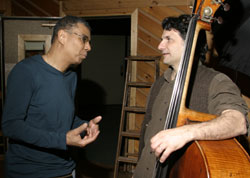 During those years('65-'69), the music department at U.C.L.A. did not even recognize the classical nylon-string guitar as an "instrument." So, where was I going to get those 'performance' credits necessary for graduation? Perform in the Marching Band? I don't think so! Perform in the choir or chorale? I don't think so! Play classical piano? I don't think so!!! The only option I seemed to have was to take a series of classes in Ethnomusicology, which would include, the music of: Bali; India; México; Japan; China; and other nations. Needless to say, my studies of the Music of India led me to compose a small suite of two pieces joined together for small Jazz ensemble with Indian instruments: tabla and tamboura. The first portion of this suite was written in 7/4 and the second portion was in 11/4. After I had moved to New York in 1970, one of my first bands was called "Future Shock" and included incredible players like: Don Grolnick, and Randy and Michael Brecker. "El Faquir" was not its original title, and I actually recorded that suite with saxophonist Steve Marcus on his LP, "SOMETIME OTHER THAN NOW." At that point in time, the most musical aspects were contributed, as usual, by Don Grolnick. Some of Don's harmonizations, composing while improvising, have now been included in this interpretation. And this is the best interpretation to date. As it now stands, "El Faquir" aspires to incorporate multi-cultural elements from Indian music, Latin music, and Jazz.
During those years('65-'69), the music department at U.C.L.A. did not even recognize the classical nylon-string guitar as an "instrument." So, where was I going to get those 'performance' credits necessary for graduation? Perform in the Marching Band? I don't think so! Perform in the choir or chorale? I don't think so! Play classical piano? I don't think so!!! The only option I seemed to have was to take a series of classes in Ethnomusicology, which would include, the music of: Bali; India; México; Japan; China; and other nations. Needless to say, my studies of the Music of India led me to compose a small suite of two pieces joined together for small Jazz ensemble with Indian instruments: tabla and tamboura. The first portion of this suite was written in 7/4 and the second portion was in 11/4. After I had moved to New York in 1970, one of my first bands was called "Future Shock" and included incredible players like: Don Grolnick, and Randy and Michael Brecker. "El Faquir" was not its original title, and I actually recorded that suite with saxophonist Steve Marcus on his LP, "SOMETIME OTHER THAN NOW." At that point in time, the most musical aspects were contributed, as usual, by Don Grolnick. Some of Don's harmonizations, composing while improvising, have now been included in this interpretation. And this is the best interpretation to date. As it now stands, "El Faquir" aspires to incorporate multi-cultural elements from Indian music, Latin music, and Jazz.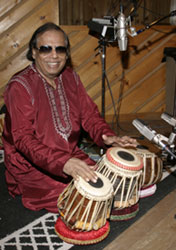 The Indian elements are supplied by the great Badal Roy on tabla, and Badal brought along his dear wife Geeta to play the tamboura with us. The Jazz elements are, of course, brought to the piece by Bob Mintzer and his bass clarinet, John Patitucci on acoustic bass, and Jack DeJohnette on drums. The Latin elements arrive with Ralph Irizarry on timbal, Manolo Badrena on varied percussion, and Roberto Quintero on güiro and Venezuelan maracas. As the January 9th, 2007 recording session began and developed, I came to feel, during countless moments, that I was attempting something a bit too grand for just one rehearsal, one where three of the principal players could not attend. And yet, there we were, gathered together in Avatar Studios 'A' trying to realize this rather ancient concept. So, much of what you now hear had to be formulated in the studio, and improvised for better or worse. The Indian elements are supplied by the great Badal Roy on tabla, and Badal brought along his dear wife Geeta to play the tamboura with us. The Jazz elements are, of course, brought to the piece by Bob Mintzer and his bass clarinet, John Patitucci on acoustic bass, and Jack DeJohnette on drums. The Latin elements arrive with Ralph Irizarry on timbal, Manolo Badrena on varied percussion, and Roberto Quintero on güiro and Venezuelan maracas. As the January 9th, 2007 recording session began and developed, I came to feel, during countless moments, that I was attempting something a bit too grand for just one rehearsal, one where three of the principal players could not attend. And yet, there we were, gathered together in Avatar Studios 'A' trying to realize this rather ancient concept. So, much of what you now hear had to be formulated in the studio, and improvised for better or worse.Truth be told, I had actually planned to record this piece, minus the Indian elements, with the Caribbean Jazz Project in 2002. We had briefly jammed on the basic ostinato at a rehearsal once and everyone seemed to love playing over it. So, while visiting Caracas during the Christmas Holidays of 2001, I got together with my dear friend, saxophonist/arranger Rafael Greco and he helped me to make a really great demo of the piece. By then, I had rewritten all of the melodic material you now hear, and better organized the 'events' as they would occur. But, as fate would have it, after some bitter artistic and business disagreements, I had to leave the band, and the piece, once again, lay dormant. Enter the planning stages for "BORROWED TIME" and the moment seemed to arrive to try to record this piece as it was originally intended. Now, out in front of the [A] melody sections, I designed an introduction which would feature a dialogue, of indeterminate length, between John Patitucci and Badal Roy, along with sonic colors from Manolo and the rest of us. That section, once completed, would flow into John's statement of the basic ostinato in 11/4, with the rest of us joining in shortly thereafter. 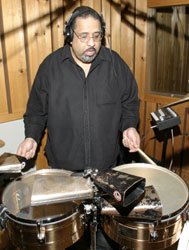 11/4! I know, this seems like a daunting task to some. I believe that this is one of those types of ostinatos where you do not have to think about counting, you can just feel the flow of the line and then go with it. The line will always bring you back. However, the possibilities for sub-division are endless. One could think of it as 6+5 over 4. Or, for the Latin elements, I like to view it as: 3 + 3 + 3 + 2 over 4.
But, this is also where my own ideas about the potential for yet another marriage between Jazz and Latin music emerges. My idea was always that, against this pulse, Jack(or any drummer) would play a double-time Jazz-oriented cymbal beat with lots of activity from the other parts of the kit. But, while that was going on, Ralph Irizarry would be playing 'cáscara'(on the shells, the sides of) the timbal. When I sent Ralph the demo and we talked about this, I think that, at first, he thought that I was crazy. But, that's O.K., I'm used to that. I told him to try to just 'forget' about the actual meter, 11/4, and relate to it all as if he was playing cáscara for three groupings of 3 and then, there just happened to be 2 extra beats. Ralph was great about it all and you can hear the results of his hard work. In addition to doing that, he has to make all the hits, setting-up the accents contained within the melodic material.
11/4! I know, this seems like a daunting task to some. I believe that this is one of those types of ostinatos where you do not have to think about counting, you can just feel the flow of the line and then go with it. The line will always bring you back. However, the possibilities for sub-division are endless. One could think of it as 6+5 over 4. Or, for the Latin elements, I like to view it as: 3 + 3 + 3 + 2 over 4.
But, this is also where my own ideas about the potential for yet another marriage between Jazz and Latin music emerges. My idea was always that, against this pulse, Jack(or any drummer) would play a double-time Jazz-oriented cymbal beat with lots of activity from the other parts of the kit. But, while that was going on, Ralph Irizarry would be playing 'cáscara'(on the shells, the sides of) the timbal. When I sent Ralph the demo and we talked about this, I think that, at first, he thought that I was crazy. But, that's O.K., I'm used to that. I told him to try to just 'forget' about the actual meter, 11/4, and relate to it all as if he was playing cáscara for three groupings of 3 and then, there just happened to be 2 extra beats. Ralph was great about it all and you can hear the results of his hard work. In addition to doing that, he has to make all the hits, setting-up the accents contained within the melodic material.After the melodies have been stated in unison by the guitar and the bass clarinet during [A] and [A2], the piece moves ahead into Bob Mintzer's free-flowing bass clarinet solo, which he humorously refers to as the "bass pain stick." I have to admit that I laugh every time I think of this. Humor amongst reed and brass players is totally another thing....way different from the way rhythm section guys screw around!!! Oops, I digress. Bob's solo is played over the hopefully hypnotic 11/4 ostinato, which begins at [B], and continues until such time as when Bob is ready to cue [B2] which is the unison cue figure out of his solo. 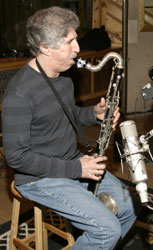 Before we go much further, I would love to point out two little moments which might pass by unnoticed but they are new elements to this piece and are important to me. In the last bar of [A], you see a harmonic cluster on the 'and-of-2' which is a tribute to the harmonies of the great Clare Fischer. On guitar, I played to the top three voices live, and then overdubbed the lower voices with the same guitar sound. Then, on a second overdub with stereo tracks, using my ESP Strat and its tremolo arm I added 4 of the voices to glue together the harmony, and to add a haunting sound to it. This same device, but with a slightly different voicing appears in [B] to serve as a harmonic send-off for Bob's solo. Before we go much further, I would love to point out two little moments which might pass by unnoticed but they are new elements to this piece and are important to me. In the last bar of [A], you see a harmonic cluster on the 'and-of-2' which is a tribute to the harmonies of the great Clare Fischer. On guitar, I played to the top three voices live, and then overdubbed the lower voices with the same guitar sound. Then, on a second overdub with stereo tracks, using my ESP Strat and its tremolo arm I added 4 of the voices to glue together the harmony, and to add a haunting sound to it. This same device, but with a slightly different voicing appears in [B] to serve as a harmonic send-off for Bob's solo.When the piece finally arrives at [C], we shift into what I would describe as a 1/2-time "Funk" feel where we still are traveling over 11 beats. However, when you hear where the Jack's backbeat is placed, this is why you have to indicate this new rhythmic approach by saying that the former quarter-note will be equal to a dotted-half-note. The correct way to write-out such a meter is to call it: 3-2/3rds/4 or three and two-thirds four. Meaning that you still have 3 groups of 3 and 1 grouping of 2. There, does that help? Again, because of the rock solid nature of the long bass tones, this is not so hard to feel and 'counting' does not seem at all necessary. Once again, I had a crazy idea about how the Latin elements could now fit here. I wrote out a pattern for Ralph's timbal, based upon the traditional 'mambo bell' pattern in 6/8, of course, that only fills 6 of the beats. So, I then added to that the 1st half of the pattern, and then invented what to do with those two 'extra' beats. Yes, you are correct! Ralph thought that I had truly lost my mind! 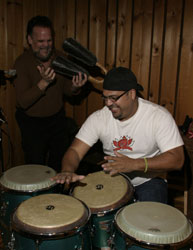 In addition to this, to change the texture, I asked Roberto Quintero to play Venezuelan style maracas. These are usually a bit more higher in pitch than other maracas. Also, as virtually all of Venezuelan folk music is in anything but 4/4, playing in a meter like this is nothing for someone like Roberto. Then, you throw in Badal Roy's tabla, and you end-up with quite a stew! I think the combination of all these elements makes for a really interesting blending of cultures and genres. As the guitar improvisation begins, I play some chord voicings which are, without question, owed to Don Grolnick. And, as usual, he heard 'changes' where once there were none. I especially like the cycling of the dominant 13th chords and the altered dominant 7th chords. I hope that he can hear this and that he is smiling and laughing with me! Thanks Don!!! The guitar improvisation progresses along, and, as has been my own little sonic tradition, it builds to the usage of my Korg DVP-1 Harmonizer. In addition to this, to change the texture, I asked Roberto Quintero to play Venezuelan style maracas. These are usually a bit more higher in pitch than other maracas. Also, as virtually all of Venezuelan folk music is in anything but 4/4, playing in a meter like this is nothing for someone like Roberto. Then, you throw in Badal Roy's tabla, and you end-up with quite a stew! I think the combination of all these elements makes for a really interesting blending of cultures and genres. As the guitar improvisation begins, I play some chord voicings which are, without question, owed to Don Grolnick. And, as usual, he heard 'changes' where once there were none. I especially like the cycling of the dominant 13th chords and the altered dominant 7th chords. I hope that he can hear this and that he is smiling and laughing with me! Thanks Don!!! The guitar improvisation progresses along, and, as has been my own little sonic tradition, it builds to the usage of my Korg DVP-1 Harmonizer.For those of you who might be unfamiliar with my usage of this device, a recently added special footswitch, designed by my pal Ralph Skelton[Pacific Innovative Electronics], enabled me to trouble-shoot the fact that the unit has NO bypass function, nor an input jack for a footswitch. Further proof that, "Necessity is the mother of invention!" Without Ralph's help, I could have never done this live. As I have explained in earlier analyses, the key for me, in using this device, is that the harmonizer programs I have created, all harmonize below the note I'm actually playing. So, even though everything you hear is in parallel harmony, the impression is that it is not, because of the melodic content of my top voice. Usually each voicing is harmonized with 3 pitches below the note I am playing. The sense of a gradual crescendo continues until I begin to play [C3] which is also something Don Grolnick once improvised. Needless to say, his presence was felt here in immeasurable ways. We play that figure 4 times before arriving at [I3] which was intended to give Jack DeJohnette some space to levitate us to a point of readiness and a cue to play [A3] and take the Coda for the Tag and the ending. 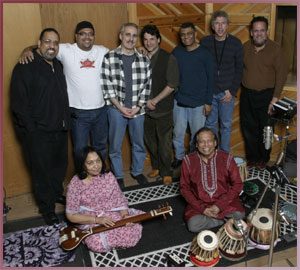 Some of you might be wondering, "What happened to Manolo during the rest of the piece?" Well, that's a most excellent question, to be sure! After the Intro, my original idea was that Manolo was supposed to play chekeré throughout the [A] sections and Bob Mintzer's solo. But, while I was attending to other musical issues, apparently Manolo and Roberto made some changes of their own, and the next thing I knew, Roberto was playing güiro. Though it did sound great and did contribute an extra 'spice' to the mix, it was not what I originally had in mind. But, I think that this is what can happen when you place to spirited artists in the same iso-booth. That was a huge error in judgment on my part!
Some of you might be wondering, "What happened to Manolo during the rest of the piece?" Well, that's a most excellent question, to be sure! After the Intro, my original idea was that Manolo was supposed to play chekeré throughout the [A] sections and Bob Mintzer's solo. But, while I was attending to other musical issues, apparently Manolo and Roberto made some changes of their own, and the next thing I knew, Roberto was playing güiro. Though it did sound great and did contribute an extra 'spice' to the mix, it was not what I originally had in mind. But, I think that this is what can happen when you place to spirited artists in the same iso-booth. That was a huge error in judgment on my part!It took us a goodly portion of that January 9th, 2007 day to get a performance of this piece, one that I could live with. But, as time has progressed, what remains has really grown on me, and I am thrilled by what we were able to achieve as a group on that day. I would not say that struggling with insufficient rehearsal time is something about which I would ever feel comfortable, but, there is also something to be said for just 'winging it' and, allowing things to play out as they will. It helps to understand the character and personalities of each of the players, because you want to be able to bring out the best in them. When everything is factored in, this was a great experience, and it will stay with me for a long time, because it is not likely to ever happen again. So, for that alone, it is something to be treasured in my memory.
[Photos: Jack DeJohnette & John Patitucci, Badal Roy, Ralph Irizarry,
Bob Mintzer, and, Manolo Badrena & Roberto Quintero @ Avatar Studio 'A', January 9th, 2007 Photos by: Richard Laird] |